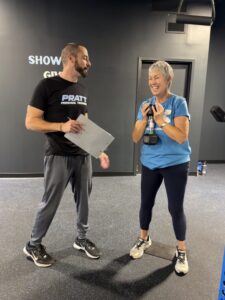
3 Powerful Reasons Why Squats Are Good for Your Knees
A few weeks ago, I was working out at the gym when a man in his 50s came up to me and said, “I wish I could squat that low. I’ve always wanted to, but I had a knee injury from an accident 20 years ago and haven’t been able to since.”
He meant it—he genuinely wanted to know why squats are good for your knees, and whether it was still possible for him. So I asked if he’d be open to trying a few things to rebuild his confidence and comfort.
He was.
He goes to the gym every morning for a full-body workout, so we added a new squat variation into his daily routine. On day one, I realized this wasn’t only about muscles—it was about mindset. He needed to trust his knees again.
1. Squats Build Strength and Trust
We started with an assisted squat—something many of our members use at Pratt Personal Training. He held onto a rope, leaned back slightly, and used his arms to reduce the load as he squatted as low as he comfortably could. Pain-free. Three sets of five, adding one rep each day.
By the end of the week, the fear was gone.
That’s one of the first reasons why squats are good for your knees: they restore confidence. When performed correctly, squats rebuild the relationship between your brain and your body. Instead of avoiding the motion that once caused discomfort, you learn to control it safely.
Strength comes from trust—and trust comes from consistent, pain-free practice.
2. Squats Improve Mobility and Range of Motion
Next, we moved to a plate-reach squat: standing on a heel wedge, holding a plate straight out, and controlling the descent. At first, he only went halfway down. But once he realized there was no pain, he felt confident enough to go deeper. Same plan—three sets of five, adding a rep per day.
Now, two weeks in, we’re preparing to progress again.
Improving range of motion is the second reason why squats are good for your knees. When you strengthen your knees in a deeper position, the surrounding muscles—quads, glutes, and hamstrings—share the workload more evenly. That reduces stress on the joints and teaches your body to handle load through its full movement potential.
The goal isn’t perfection—it’s progress. Each inch of extra depth builds strength and stability where your body once felt vulnerable.
3. Squats Reduce Pain Through Proper Loading
Why do so many people experience knee pain relief after consistent training? Because smart loading builds resilience.
Years ago, when I played football in college, I dealt with chronic knee pain. I assumed it would stick around for life. But once I committed to full-range strength training—and learned firsthand why squats are good for your knees—that pain nearly disappeared.
Fifteen years later, I train almost daily and experience almost zero joint pain.
When performed under proper guidance, squats strengthen every structure that supports the knee: the muscles, tendons, and connective tissue. That’s why our coaches at Pratt Personal Training emphasize range first, load second. Get strong at the bottom, and the top takes care of itself.
Mindset: From Fear to Freedom
Sometimes the exercises you fear most are the ones that help you most. Avoiding squats after a knee injury might seem protective—but it can actually limit healing by keeping the joint weak and stiff.
If you’re nervous about squatting again, start with assisted variations, body-weight drills, or supported holds. Build confidence rep by rep. You might be surprised how quickly progress returns once you start moving again.
With the right coaching, almost everyone can squat. In fact, at Pratt Personal Training, we believe 99 % of people should be able to perform some type of squat variation safely and confidently.
The Bottom Line
So, why squats are good for your knees isn’t a mystery—it’s movement science. They strengthen the muscles that protect your knees, increase range of motion, and teach your body to move with confidence.
If you’ve been avoiding squats because of pain or fear, consider starting small. Assisted squats, heel-elevated squats, or plate-reach squats can all help you rebuild strength and trust—one rep at a time.
At Pratt Personal Training, we’ve helped hundreds of members overcome similar challenges by focusing on movement quality, not just numbers.
Take it slow, listen to your body, and remember: the exercises you avoid often hold the key to the progress you want most.
